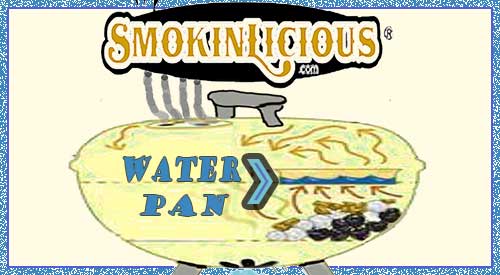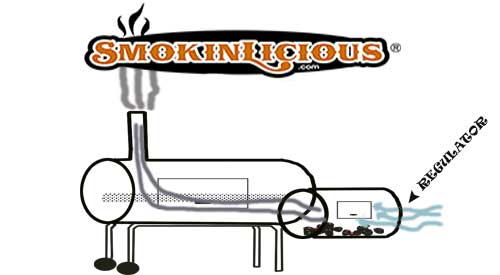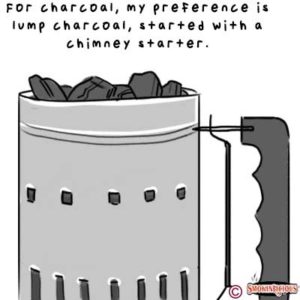Fri 15 May 2020
THE WATER PAN IN SMOKER
Posted by DrSmokeRead other related stories: Charcoal Grilling , General Smoking Information , Grilling
No Comments

The Water Pan in Smoker explained for grilling and smoking techniques!
THE WATER PAN IN SMOKER EXPLAINED FOR GRILLING & SMOKING Share on X

If you’ve purchased a smoker, you’re likely familiar with the term “water pan”. If, however, you’re more of an LP/Gas Grill person, than this term is likely one that escapes your knowledge.
Water pans are a means of introducing valuable moisture into the cooking environment which has immense value when grilling and smoking. Let me explain each of the pros of learning and using a water pan for your outdoor cooking, no matter the type of equipment you’re cooking on.
Water Pan Pro #1
Temperature control. This is the ultimate need when you grill or smoker, especially when you smoke. Maintaining a stable temperature that you’ve predetermined. When the day is scorching hot and the equipment is made of metal, you will experience a challenge with temperature control. Introduce a water pan, and your battle can be won.
A water pan goes above the heat source. If using a charcoal grill or charcoal/wood smoker, this pan would be placed above the coal area. Have an electric unit and you’ll find the pan over the electric heating element. If you want to introduce a water pan on an LP/Gas Grill, this would be placed over the lit burners. Many vertical smokers come with a water pan.
Water Pan Pro #2
Water cannot go above the boiling point which is 212°F. Additionally, evaporative cooling also takes place as the water is exposed to heat.
Water Pan Pro #3
A water pan can become the number one tool when doing direct heat cooking over an open flame. Why? It acts as a repellent for the flame giving your foods a chance to survive without becoming a blackened, dried out, former piece of food.
Water Pan Pro #4
Are you having trouble with hot spots in your equipment? Well, a water pan will even them out. Now, the temperature you desire can essentially be locked in just by using a water pan.
Water Pan Pro #5
Humidity that develops from the use of a water pan keeps the surface of the meat moist, which in turn, attracts smoke vapor, which in turn, produces great flavor. The water vapor mixes with the combustible gases which are emitted from the burning material and add to the overall flavor. Yes, water is a passageway to all things flavorful!
What Goes in the Water Pan
It’s called a water pan for a reason. It is designed to hold water, specifically hot water to keep the cooker from wasting energy on heating cold water put in the pan. Here’s a tip when you fill the water pan: use a teapot to fill the pan while it’s in place so you don’t take the chance of spilling hot water on surfaces or you. Remember, water evaporates while other liquids don’t evaporate.
Don’t Make the Water Pan a Drip Pan
Here’s the thing with a drip pan. Due to its location directly over the heat source, when used on vertical units it often serves double duty as a drip pan. Don’t do that! Here’s why. The rendered fat drippings can produce an oil slick on the surface of the water which will prevent water evaporation.
Make Cleaning a Snap
Here’s a couple of tips when using a water pan. If your unit comes with a water pan, line it in aluminum foil which will allow you to simply pull the foil off and preserve the condition of the original pan.
If you’re using a unit that has no water pan but want to introduce one, simply purchase a disposable foil pan. You will want to purchase one that is compatible in size to the unit your using, that will fit comfortably over the heat source, and that can hold enough water to prevent you from having to make refill trips every 15 minutes.
Purchase products:
Wood Chips- Grande Sapore®, Minuto® & Piccolo®
Wood Chunks- Single & Double Filet

More Related reading on water pan in smoker, see our links for related readings
Additional reading
-PREVENTING DRY BBQ IN YOUR SMOKER
-CAN HARDWOOD BE TOO DRY FOR COOKING?
-TURNING YOUR CHARCOAL GRILL INTO A SMOKER
-TURN YOUR LP/GAS GRILL INTO A SMOKER
www.barbecue-smoker-recipes.com

Dr. Smoke- The water pan in smoker explained is essential for moist results in grilling and smoking.
Our Readers Are Asking…
What does water pan do in a smoker?
A water pan induces moisture directly into your smoker as an ally for the indirect dispersion of heat. Never use your water pan as a drip pan. Remember- drip pans = a collection unit for residual or run off grease from the cooking process; a water pan = water for moisturizing foods.


